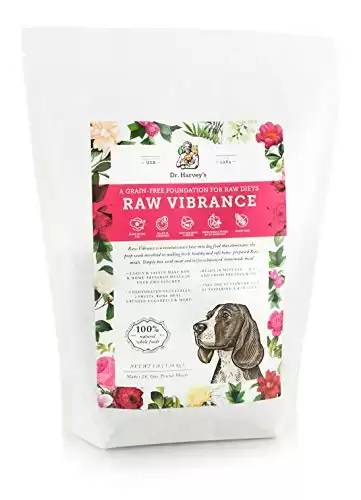Springerdoodle
Canis lupus
Springerdoodles are well suited to be therapy dogs and emotional support animals.
Advertisement
Springerdoodle Facts
- Fun Fact
- Springerdoodles are well suited to be therapy dogs and emotional support animals.
- Temperament
- Easy to train, energetic, loyal, fun-loving
Springerdoodle as a Pet:
- General Health
- Energy Level
- Shedability
- Trainability
- Intelligence
- Tendency to Chew
- Size
- Family and kid friendliness
- Yappiness / Barking
- Low
- Hypoallergenic
- Yes
- Separation Anxiety
- Moderate
- Preferred Temperature
- Cold climate
- Exercise Needs
- High
- Friendly With Other Dogs
- High
- Pure bred cost to own
- $1,000 to $2,800
- Dog group
- Toy
- Male weight
- 5-60 lbs
- Female weight
- 5-55 lbs
This post may contain affiliate links to our partners like Chewy, Amazon, and others. Purchasing through these helps us further the A-Z Animals mission to educate about the world's species.
View all of the Springerdoodle images!
Springerdoodles are nicknamed “sproodles.”
What do you get when you cross the sporty English springer spaniel with the sassy poodle? The fun-loving springerdoodle! These hybrid dogs, which are often referred to as designer dogs, reflect the best traits of both parent breeds. Like springer spaniels, springerdoodles are active, energetic, loyal, and easy to train; like poodles, they are smart, fun-loving, and have a mischievous streak. Sproodles, as they are also called, are among the most popular of the 44 different types of poodle mixes affectionately known as “doodles.”
See all of our expert product reviews.
Depending on the size of the parent poodle line, springerdoodles can be standard- or mini-sized. The breed is thought to have originated in the U.S. sometime in the 1980s or 1990s when hybrid dogs first became popular. The International Designer Canine Association first recognized the breed in 2009. If you’re looking for a pet that’s easygoing, intelligent, and active, and that just loves being around people, the springerdoodle is your dog.
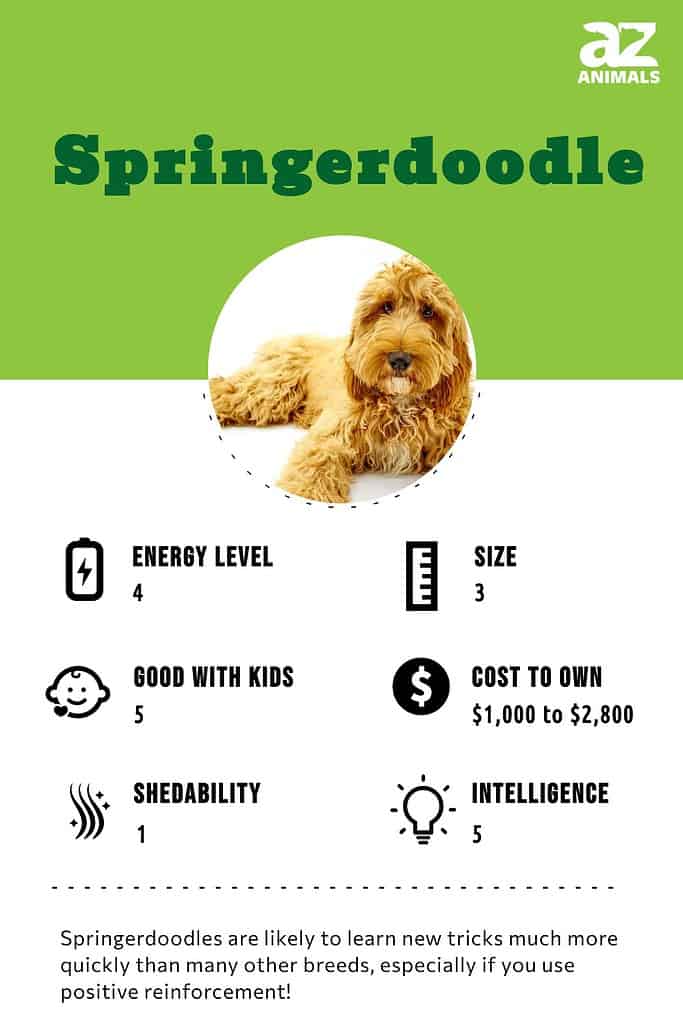
3 Pros and Cons of Owning Springerdoodle
| Pros! | Cons! |
| They’re sociable: They work and play well with others. They’ll hit it off as well with the letter carrier as they will with your children. These dogs are great for blended pet families, too, because they get along well with other canines and even with cats. They can be trained as therapy dogs. | They’re bad watchdogs: A springerdoodle’s reaction when it sees a stranger will probably be to go up to that stranger, sniff his or her shoes, and wag its tail. They do not make good guard dogs. |
| They’re active: They love to exercise. If you’re someone who’s considering getting a dog because you know you need to be more active, a springerdoodle will turn spending time outside from a chore into a pleasure. | They may have health issues: While hybrid vigor makes some designer dogs healthier than their breeding lines, others may not inherit the best genetic traits from their parents. If you are interested in owning a dog of this variety, it’s a good idea to make sure your pup is genetically tested to rule out the development of serious health issues down the line. |
| They’re hypoallergenic: One of the reasons for the increasing popularity of poodles and poodle mixes is that poodles shed less hair and dander than other dogs, so they are frequently described as hypoallergenic. If your pet inherits a non-shedding coat from its parent poodle line, then it’s likely to be hypoallergenic, too. | They’re expensive: As these dogs are a relatively new mix, there are no rescue groups. If you want a springerdoodle, you’ll have to raise one from a pup. Responsible breeders put a lot of time and money into finding good breeding stock, providing quality vet care, performing genetic testing, and socializing puppies. That effort is reflected in their costs. |

One reason for the increasing popularity of springerdoodles and poodle mixes is they shed less hair and dander than other dogs.
©Kitch Bain/Shutterstock.com
Evolution and History
As with many hybrid dog breeds, there is little information about exactly when the springerdoodle was first bred. It’s thought the dog was introduced in the late 20th century and there’s a high probability it was developed during the 1980s-1990s when there was a demand for “designer dogs” and a surge in popularity for dogs that were crossed with the poodle.
The springerdoodle’s parent breed the springer spaniel originated in Spain. It’s likely the “spaniel” part of its name comes from its country of origin and the “springer” refers to the technique of flushing or springing to chase birds and game up into the air when assisting hunters.
Health and Entertainment for your Springerdoodle
See all of our expert product reviews.
The dogs were imported in the late 12th century into England and in the 1810s the Boughey family in Shropshire began to develop the breed that would become what we know today as English springer spaniels. By the 1920s, these dogs became popular in the U.S. and are now used as K-9 operatives due to their intelligence, ability to focus, and keen sense of smell.
The springerdoodle’s other parent breed, the poodle, was also originally used as a hunting dog and was an excellent dog to retrieve waterfowl due to its intelligence and gentle bite. Some believe that the poodle has French origins on account of its popularity in France, including being named the country’s national dog in 1786 and famous poodle fans being French royalty such as King Louis XVI. But it’s more likely that the poodle was first introduced in Germany.
A smaller breed of the standard poodle, the miniature poodle, was also used for hunting, although its target was often truffles in the woods. The smallest variety of the poodle, the toy poodle, was bred to be even more compact. It was popular as a lapdog to nobility as well as with circus performers, who incorporated the dogs into their acts due to their smaller size and their obedience, trainability, and intelligence. In 1874, the Kennel Club in England registered its first poodle and the American Kennel Club registered its in 1886. By the 1950s, the poodle had become one of the most popular breeds in the U.S.
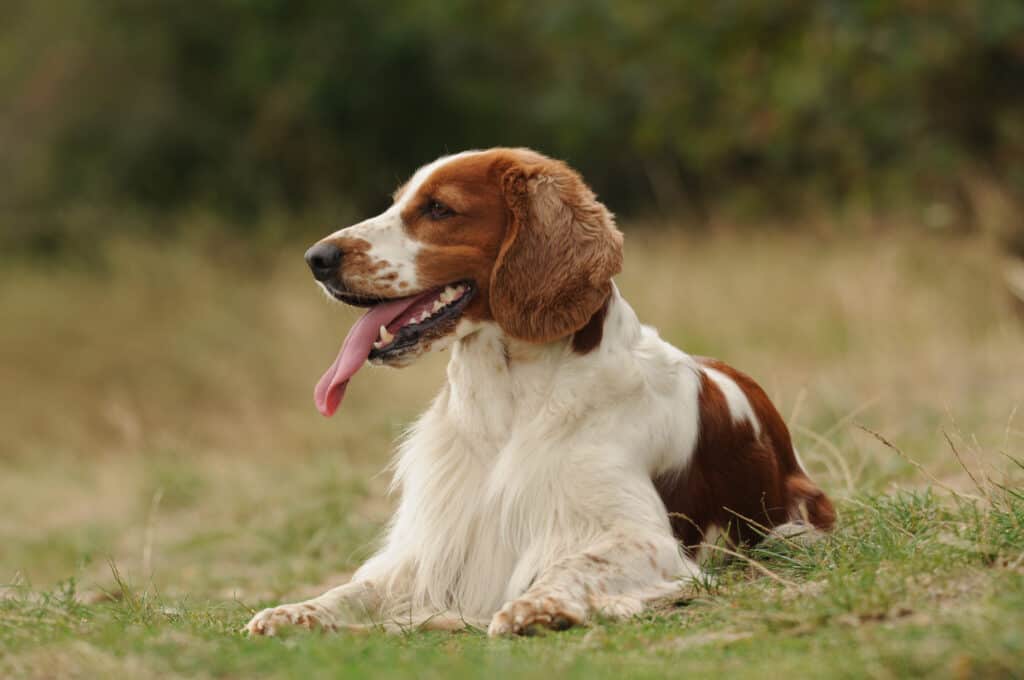
The springer spaniel, one of the springerdoodle’s parent breeds, was originally used as a hunting dog in Spain.
©Dusan Vainer/Shutterstock.com
Size and Weight
Springerdoodle size depends upon the size of the poodle line from which it was bred. Standard sproodles can weigh anywhere from 30 to 60 pounds and stand up to 24 inches in height. Mini springerdoodles weigh between 5 and 25 pounds and are 10 to 15 inches tall. They will typically reach their full-grown weight and height by 18 months of age. Females are slightly smaller than males.
| Height (Male): | Variable, but up to 24” tall |
| Height (Female): | Variable, but up to 22” tall |
| Weight (Male): | Variable, but up to 60 pounds |
| Weight (Female): | Variable, but up to 55 pounds |

Springerdoodles generally reach their full-grown weight and height by 18 months.
©jack-thorp/Shutterstock.com
Common Health Issues
In general, the springerdoodle is a hardy dog. However, springerdoodles can be susceptible to all the health conditions that affect their parent breeds, particularly if the parent stock was highly inbred. That means your sproodle may be at risk for developing hip dysplasia, progressive retinal apathy, Addison’s disease, and thyroid issues.
If at all possible, it’s advisable to do genetic testing on any puppy you’re interested in buying before you take it home. Regular vet visits throughout your dog’s lifespan should also help keep health conditions under control.

Springerdoodles can be vulnerable to all the health conditions that affect their parent breeds.
©Kitch Bain/Shutterstock.com
Temperament
Springerdoodles are highly intelligent and very rarely display overtly aggressive behavior. Sproodles are easy to train and thrive on mental and physical stimulation. They are likely to learn new tricks far more quickly than many other breeds, particularly if you use positive reinforcement because they bask in the praise of their owners. The breed is a natural at agility and other canine sports. These dogs are also well suited to be therapy dogs and emotional support animals.
Sproodles do best in large houses with a lot of space, but so long as you keep up with your dog’s need for exercise, they can thrive in apartments, too. This dog has a loyal and sociable personality that makes him or her a great fit for single individuals, first-time dog owners, and senior citizens as well as for the traditional large family with children.
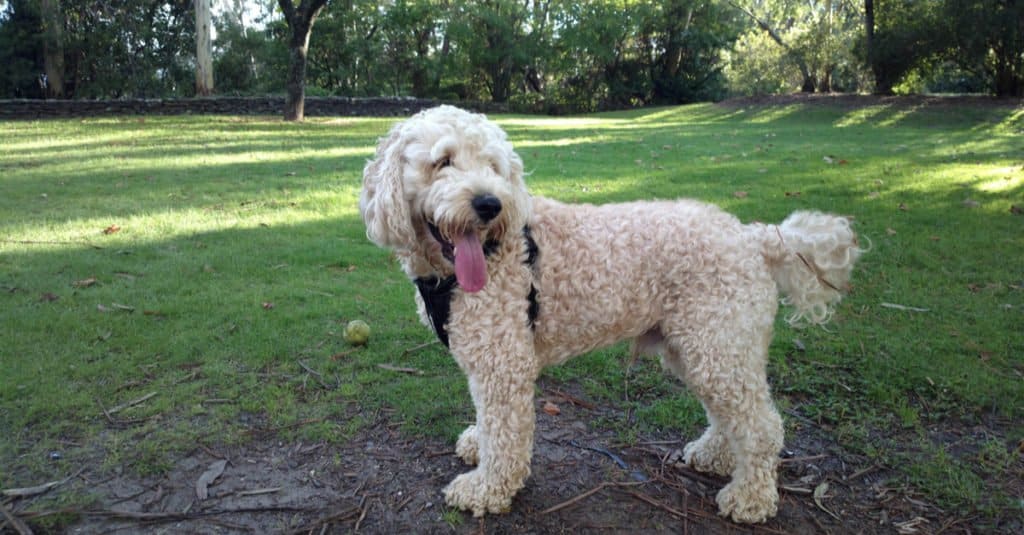
Springerdoodles are sociable dogs who rarely display any aggression.
©Jaaske M/Shutterstock.com
How to Take Care of A Springerdoodle
Springerdoodles are not a one-size-fits-all kind of dog. Every sproodle puppy is unique, so owners need to pay close attention to get a handle on their pet’s specific needs. In general, though, these dogs are characterized by energy, intelligence, and a need to stay emotionally close to their humans.
The Best Dog Food for Springerdoodles
For the most part, springerdoodle owners who get a dog from a responsible source can rest assured that their dog will likely stay healthy for a long time. Although there aren’t many prevalent health problems to worry about for guiding your dog’s nutritional needs, you still want to feed your dog the most wholesome food around. Organic dog food is an excellent start.
For springerdoodle owners that won’t settle for less when it comes to their dog’s diet, A-Z Animals suggests Dr. Harvey’s Raw Vibrance Dog Food, Human Grade Dehydrated Base Mix for Dogs, Grain-Free Raw Diet.
This holistic food sources its wide range of nutrients from 24 unique whole foods such as goat’s milk, mussels, bone meal, and eggshell membranes for calcium. Simply mix in a protein of your springerdoodle’s choice for a well-rounded meal.
Find Dr. Harvey’s Raw Vibrance Dog Food on Amazon.
- Nutritious all natural raw dog food
- Contains fruits, vegetables, superfoods, bone meal & crushed eggs, seeds
- Promotes, energy, digestion, shiny coat, immune health
Springerdoodle pups should be fed specially formulated puppy food three or four times a day. A pup younger than a year old should be fed about 1 cup of food a day. By a year old, your sproodle puppy will be ready for adult food.
Full-grown dogs typically eat between 1 ½ and 3 cups of high-quality kibble divided into two meals every day. If you augment this with wet dog food, you will need to cut back on the kibble. Since no two springerdoodles are ever quite the same, there’s some variation in what constitutes the optimal sproodle diet, too, so it’s a good idea to check with your veterinarian if you have any questions about your pet’s specific dietary needs.
Maintenance and Grooming
Depending on what kind of parents your springerdoodle had, your dog’s coat can be curly, wavy, or straight. Some sproodles’ soft, double-layered coats are medium while others are long. Daily brushing will prevent mats from forming. A trip to the groomer every six weeks or so for a clipping will help keep your dog cool in the warmer months. Springerdoodles don’t need to be bathed regularly, but their ears should be checked for dirt every day, and their coats should be checked for twigs, leaves, and other detritus especially if they spend time in a yard unsupervised. As with all dogs, their teeth should be brushed once a day.
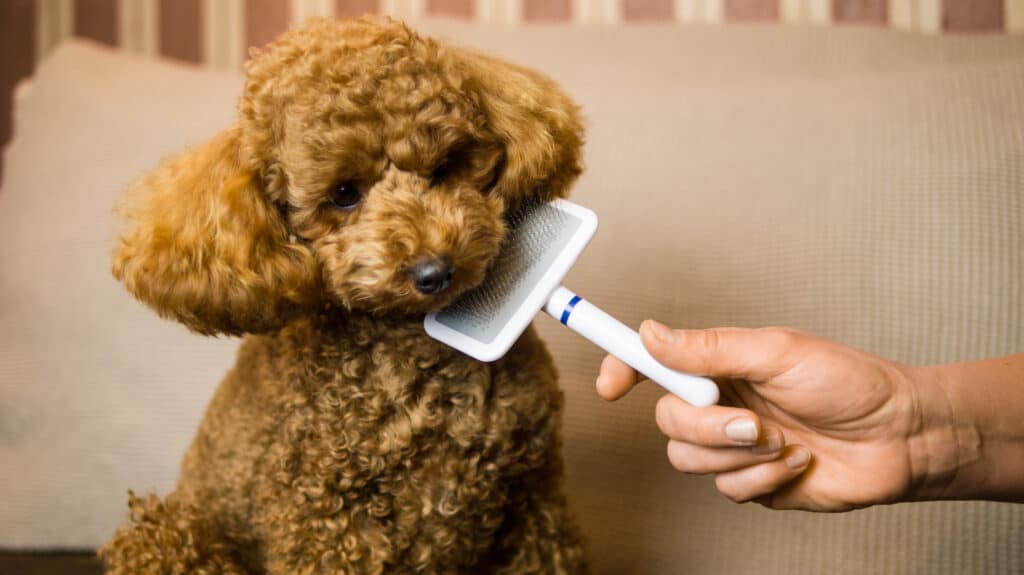
Springerdoodles, like their parent breed poodles, need their coats brushed daily.
©Kristina Arba/Shutterstock.com
Training
Like their poodle and springer spaniel parent strains, springerdoodles are remarkably easy to train. They often grasp tricks after just a few repetitions, especially if you use rewards to reinforce what they’ve just learned. Sproodles thrive on mental stimulation, in fact, so the more tricks you can teach your dog, the happier your dog is likely to be.
Springerdoodles need lots of exercise, so plan on at least one long walk every day and frequent visits to the dog park where your sproodle can chase balls and run around with other dogs off-leash. Begin leash training with a new puppy as soon as you can. These pets love to swim, too. For full-grown dogs, strive for 60 minutes of exercise a day and walking distances of at least 15 miles a week.

Like its poodle parent breed, the springerdoodle is very easy to train.
©HelloAnnMe/Shutterstock.com
Puppies
Springerdoodle pups aren’t bred from springerdoodle parents, so no two springerdoodle puppies are ever identical in appearance or temperament. Two pups from the same litter can grow up into adult dogs that look completely unalike depending upon whether they reflect the physical characteristics of the springer spaniel or the poodle parent. There’s a certain amount of the unknown when you decide to adopt a sproodle pup.
This is why it’s very important to make sure you’re dealing with a reputable breeder. A responsible breeder is one who keeps clean premises, invests in vet services and genetic testing, is hands-on with early socialization and training activities, and asks you questions to make sure you’re bringing your pup into a good home. Check with your vet or a local chapter of the International Designer Canine Association for recommendations.
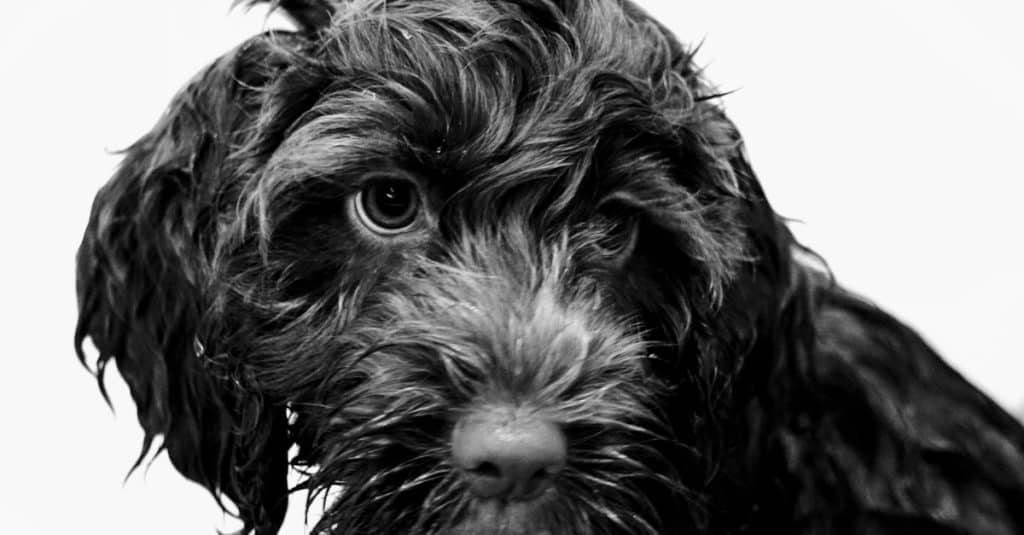
If your springerdoodle inherits a non-shedding coat from its parent poodle line, then it’s likely to be hypoallergenic, too.
©Jeremy Kofsky/Shutterstock.com
Springerdoodles and Children
Springerdoodles get along fabulously with children. After all, they both love to play. These dogs are loyal and forgiving, and they are not big barkers. Of course, sproodle puppies should not be left unattended around young children who don’t yet know their own strength. Similarly, older dogs should be chaperoned when they’re in the presence of toddlers.
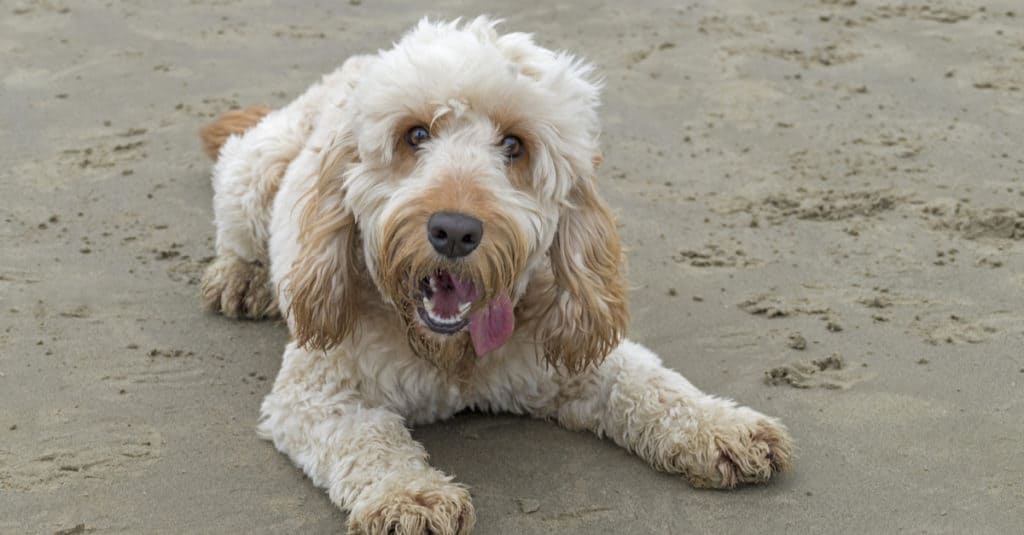
Springerdoodles are great for families with kids as these dogs love to play.
©CLRgraphics/Shutterstock.com
Springerdoodle vs. Goldendoodle
Goldendoodles are another poodle hybrid and a mix of poodle and golden retriever lines. Both breeds are cheerful, outgoing animals who are rarely aggressive and who make great companions for young and old alike.
They both have a double-layer coat composed of wavy, dense fur that sheds minimally. Both breeds come in a spectrum of colors that range from white through cream, apricot, and brown to black — though on the whole, goldies are lighter in color than sproodles. Like springerdoodles, goldies range in size from mini to standard, depending upon the size of the poodle bred to the golden retriever. In the same way golden retrievers are larger than springer spaniels, so the typical goldie tends to be larger than the typical springerdoodle.

Goldendoodles are another hybrid poodle mix as cheerful and outgoing as springerdoodles.
©SoySendra/Shutterstock.com
Other Dogs Similar to A Springerdoodle
Springerdoodles are similar to other poodle hybrids such as the cockapoo, the Labradoodle, and the Irish doodle:
- Cockapoos: Cockapoos, which are a cross between poodles and cocker spaniels, are the original designer dog. Like sproodles, they are super smart, kid-friendly, and hypoallergenic. If you’re not interested in raising a pup, contact a rescue mission dedicated to finding new humans for adult sproodles if you’re interested in owning one.
- Labradoodle: Labradoodles combine the athleticism and work ethic of their poodle and Labrador retriever parents. If they are slightly more hyper than springerdoodles, proper training will make them tractable. Again, there are many labradoodle rescue nonprofits that can help you find a suitable adult pet.
- Irish doodles: The Irish doodle is a relatively recent mix of poodle and Irish setter lines. They are known for their wavy red hair and their long, floppy ears. Responsible Irish doodle owners know they have to get serious about grooming, but these smart, sassy, showpiece dogs make it worth the extra trouble.

Like springerdoodles, cockapoos are super smart, family-friendly, and hypoallergenic.
©Lee Ph/Shutterstock.com
Popular Names for A Springerdoodle
Popular names for springerdoodles include:
- Bailey
- Bella
- Kingsley
- Max
- Poppy
Springerdoodle FAQs (Frequently Asked Questions)
How much does a springerdoodle cost to own?
Springerdoodle breeders charge anywhere between $1,000 and $2,800 for a pup, depending upon the lineage of the parent stock. Expect to spend approximately $500 on other puppy-related costs such as shots, chipping, neutering, collars, leashes, and crates. You will spend around $1,000 a year on food, training, and toys for your adult sproodle and another $600 a year on vet bills.
Is the springerdoodle good with kids?
Springerdoodles and kids are a match made in heaven.
How long do springerdoodles live?
Springerdoodles typically live between 10 and 15 years.
What is a springerdoodle?
Springerdoodles are a cross between poodles and springer spaniels.
How do you groom a springerdoodle?
Springerdoodles need to be brushed daily so that their thick coats do not become matted.
Do springerdoodles shed?
Though springerdoodles are relatively hypoallergenic, they do shed a little.
How big are springerdoodles?
Springerdoodles vary in size according to whether they’re mini or standard. Mini springerdoodles weigh between 5 and 25 pounds, and are 10 to 15 inches tall. Standard springerdoodles weigh between 30 and 60 pounds and are 24 inches tall.
Thank you for reading! Have some feedback for us? Contact the AZ Animals editorial team.
Sources
- petguide.com / Published March 10, 2021
- wagwalking.com / Published March 10, 2021
- thehappypuppysite.com / Published March 10, 2021
- hillspet.com / Published March 10, 2021
- marthastewart.com / Published March 10, 2021
- pethelpful.com / Published March 10, 2021
- dogtime.com / Published March 10, 2021
- thisdogslife.co / Published March 10, 2021






